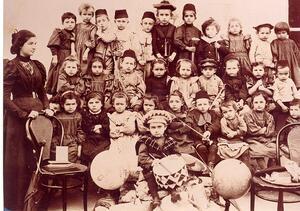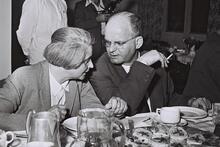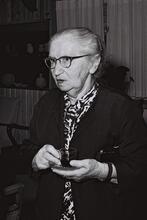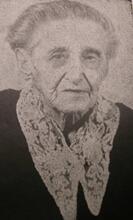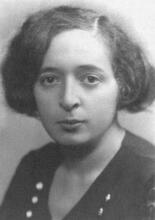Kindergartens in Palestine: First and Second Aliyah (1882-1914)
Students and teacher at a kindergarten in Rishon le-Zion, ca. 1898. Source: Museum of Rishon le-Zion, via Wikimedia Commons.
Beginning in the 1880s, the Zionist pioneers of the First Aliyah established agricultural settlements as well as educational institutions, where children were provided shelter, proper nutrition and care, and, most uniquely, education entirely in Hebrew. These kindergartens were staffed almost entirely by women. While many of the women of the First Aliyah had not received proper training as teachers, during the Second Aliyah the majority had. Despite the professionalization of the kindergartens, the future of these schools was repeatedly threatened by local authorities, who viewed elementary and high school education as more important. If not for the dedication of the teachers to their students and their belief in the importance of Hebrew education for the Zionist movement, the kindergartens may not have survived.
Overview
Today, it is impossible to conceive of a proper educational system that does not include kindergartens. But this was not the case in the late nineteenth century, when the earliest pioneers reached Palestine, began to establish agricultural settlements, and laid the cornerstone for the country’s earliest educational institutions. The undertaking known as “Hebrew education” began in 1888 in Rishon le-Zion, the Lit. "village." The dominant pioneer settlement type of the Jews in Palestine between 1882moshavah (cooperative agricultural village) of the First Lit. "ascent." A "calling up" to the Torah during its reading in the synagogue.Aliyah pioneers. That year marked the opening of the first school in the country to have Hebrew as its language of instruction. Ten years later, in 1898, the first Hebrew-speaking kindergarten in the country was inaugurated, paving the way for the establishment of similar institutions, which were key factors in the consolidation of Hebrew education and culture.
At the time, kindergartens represented a genuine revolution in the field of education. They were a novel educational setting, unique in pre-state Palestine, both in terms of their objectives and their educational approach. The goals of the kindergarten, apart from a certain degree of learning, were the inculcation of the Hebrew language, the safeguarding of the children’s health, childrearing advice for mothers, proper nutrition, and attention to assorted and challenging problems stemming from the difficulties of life in Palestine: infectious diseases, malnutrition, and poor sanitary conditions. Illness led to disruptions in learning, since it fell to the nurse and kindergarten teacher to offer medical treatment to children infected with ringworm and trachoma and to find immediate solutions for those suffering from malnutrition.
The kindergarten setting provided many children aged three to six with their first opportunity to play, hike, sing and dance, or listen to a story, all in Hebrew. In the words of a kindergarten teacher from the First Aliyah: “The most responsible, and perhaps the most difficult, task in education fell to the kindergarten teachers. … And if we have been privileged to see our language spoken by our children and by the Jewish masses, the kindergarten teachers deserve no small credit for this achievement” (Eisenberg-Harari 1959, 441).
Despite their importance, the kindergartens were forced to struggle to survive. They were located in substandard, overcrowded settings, in faulty structures or rented apartments generally unsuited for this purpose. At times, up to 50 children of assorted ages were under the supervision of only one teacher and an aide. The kindergartens operated despite a severe shortage of funds for even the barest essentials needed for ongoing maintenance and future development. They managed to carry on despite a lack of proper equipment, toys, physical-education facilities, learning materials, and basic furniture and supplies, as well as the absence of proper sanitary conditions.
During the pre-State years, the Hebrew kindergartens experienced many severe crises coupled with far-reaching changes in educational concepts, work methods, and curricula. While the public came to recognize their vital importance in the revival of the Hebrew language and their educational and national value, they did not always win the support of the authorities. On more than one occasion they were in danger of closing and were “first in line” for budget cuts. Had it not been for the resolute stance of the first kindergarten teachers, it is doubtful whether the pre-state kindergartens as a whole would have developed so rapidly. It was the Hebrew kindergarten teachers of the First and Second Aliyah who laid the foundations; and it is thanks to their single-mindedness, their dedication and their faith, that the dream of establishing Hebrew kindergartens in Palestine was fulfilled.
The Teachers
The stories of the first kindergarten teachers belong to the larger story of the first educators in pre-State Palestine. For these young women, working conditions and wages were of secondary importance to the national/educational purpose of the kindergartens. The first kindergarten teachers set up kindergartens at a time when the educational system was still undefined: training colleges for kindergarten teachers did not yet exist in Palestine, curricula had yet to be written, working procedures had not been formulated, and, most importantly, the children were not yet accustomed to Hebrew.
The kindergarten teachers of the First Aliyah (1882–1903) immigrated to Palestine in early childhood from Eastern Europe and settled in the first moshavot. They completed their schooling in their communities, where they received a modern nationalist-Hebrew education. Most of them were outstanding students, which led to their selection as kindergarten teachers. They began working in the kindergartens as non-professionals while only sixteen or seventeen years old. Interestingly enough, not one of them “dreamed” of being a kindergarten teacher, and it was only their life circumstances that led them to this vocation; moreover, they did not study at a teachers’ college, for no such institution yet existed in Palestine. Although they obviously lacked theoretical and practical knowledge in the field, they began working in the kindergartens even without any formal pedagogical learning. They obtained their professional training through hands-on experience in one another’s kindergartens and received a kindergarten teacher’s certificate from the moshavah committee after being tested in their practical skills by teachers, members of the committee, and the supervising kindergarten teacher.
The kindergarten teachers of the Second Aliyah (1904–1914), who carried on the work of their counterparts from the First Aliyah, were also mainly from Eastern Europe. Unlike their predecessors, however, they arrived as young women, most of them alone. They settled in the cities, primarily Jerusalem and Jaffa. All of them had received a general traditional education as children, were raised in a Zionist environment, and spoke Hebrew fluently. Some had already been involved in Zionist activity in their native countries and they all shared a longing to immigrate to Palestine. Most had trained as teachers even prior to their aliyah, with the intention of teaching in a preschool setting, and they arrived with a kindergarten teaching certificate in hand. They brought with them curricula, work methods, and fresh ideas that were sweeping the world in the field of preschool education. They refined the methods of instruction in the kindergartens based on the teachings of Friedrich Froebel (with adjustments to the local reality), until the concept of kindergartens secured its rightful place in the network of existing education institutions and its status in the emergent society of Palestine.
Owing to their professional training in Europe, many of them also found work training others at the newly founded colleges for kindergarten teachers in Palestine. In 1914, one such Hebrew-language teachers college, headed by Hasya Sukenik-Feinsod, was inaugurated in Jerusalem. In 1919 it was merged with the Lewinsky Teachers Seminary in Jaffa. Kindergarten teachers of the Second Aliyah taught and supervised at both these institutions, laying the groundwork for the formulation of training curricula for kindergarten teachers in Palestine.
Certain of the Second Aliyah kindergarten teachers were specially trained to work in kindergartens at the request of the Hilfsverein der Deutschen Juden (Relief Organization of German Jews). Upon their arrival, they were assigned the task of running its kindergartens, also serving as instructors at the teachers’ college established by the Society in Jerusalem in 1909. They improved teaching and work methods in the kindergartens, adapting them as much as possible to the situation in Palestine. Indeed, there was a noticeable change for the better, primarily in the kindergartens of Jaffa and Jerusalem, two cities where many kindergarten teachers of the Second Aliyah settled. Those kindergarten teachers who arrived without formal certification began working in kindergartens and specializing in the profession; only after working for no less than a year did they go to Berlin and complete their pedagogical training at a teachers college for kindergarten teachers.
The most outstanding of these teachers were active in the community and played a role in women’s groups that sought to advance women’s rights in Palestine. They were the standard-bearers in the fight of the kindergarten teachers for recognition of their professional status and in 1919 founded the Association of Kindergarten Teachers as an independent section of the Hebrew Teachers Association. The first three presidents of the Association of Kindergarten Teachers came to Palestine as part of the Second Aliyah.
Difficulties and Work Methods
Among the difficulties encountered by kindergarten teachers of both the First and Second Aliyah was the attitude of the local authorities and the directors of the Education Department of the Va’ad Leummi, who argued more than once that the kindergartens should be shut down to free up resources for the elementary schools and high schools. A severe shortage of textbooks and professional/pedagogic literature written in Hebrew, which was crucial to the teachers’ professional development, presented a further obstacle. The lack of a common language in the kindergartens meant that their primary task was to overcome the babble of different tongues and help the youngsters acquire Hebrew.
For the kindergarten teachers of the First Aliyah, the road was long and hard, with numerous hurdles along the way. Kindergartens and the profession of kindergarten teacher were still in their infancy. Teachers were scattered throughout the country without the opportunity for professional contact or collaboration; nevertheless, they were constantly seeking new methods of instruction, and were filled with hope and a passion to develop this under-funded educational endeavor.
Even amid rioting and war, the teachers remained “at their post,” toiling with endless dedication to keep the doors of the kindergartens open. They remained faithful to the cause, supporting the kindergartens until they took root and earned the right to exist independently as first-class educational institutions. Thus the vital role of the kindergartens, and the hard work and dedication of the kindergarten teachers, gradually earned the respect and recognition of the public.
The early teachers are noteworthy for their admirable dedication, their adherence to the pioneer-Zionist goal of establishing a system of kindergartens where none had existed, their struggle to develop preschool education, and their sacrifice and profound concern for the children of Palestine. Their success proves that “devoted fanatics,” with unique qualities and motivations—determination, dedication, persistence and belief in the cause—were able to bring about a true revolution in the lifestyle and education of the children of pre-State Palestine.
It is fitting to quote the words of praise for kindergarten teachers and the Hebrew kindergarten offered by Hayyim Aryeh Zuta (1868–1939), one of the first Hebrew-speaking educators in Palestine, on the occasion of the General Assembly of the Association of Kindergarten Teachers, which took place in Jerusalem on October 19, 1921: “The Hebrew kindergarten is the original creation and the foundation of Hebrew education in Palestine. The perfecting, the improving, of the kindergarten; the professional and general development of the Hebrew kindergarten teacher; and the betterment of the material situation of this important institution and of those who work in it, are the surest guarantee of both the development of the schools and a new life for our people in our land” (Gannenu 1922, 154).
Academy of the Hebrew Language, Aaron M. Masie Institute for the History of the Revival of the Hebrew Language. File 8/1
Aviezer Yellin Archives of Jewish Education in Israel and the Diaspora, Tel Aviv University. Kindergarten Teaching files.
Central Zionist Archives. Archives of David Ideolovitch, Jerusalem. Files A192/634, A192/918, A192/630.
Central Zionist Archives, Jerusalem. Files S2/326, S2/327, S2/539, S2/689.
Eisenberg-Harari, Yehudit. Ishah ṿe-ʼem be-Yiśraʼel : mi-teḳufat ha-Tanakh ʻad shenat he-ʻaśor li-Medinat Yiśraʼel (Woman and Mother in Israel: From the Biblical Period to the State of Israel). Tel Aviv: Masadah, 1959.
Gannenu (journal for kindergarten teachers) 4–5 (April 1922).
Katerbursky, Zivia. In the Footsteps of the Kindergarten (Hebrew). Tel Aviv Otzar Hamoreh, 1962.
Rishon le-Zion Museum. Historical Archives. File H1–2, Kindergarten file.
Rishon le-Zion Museum. School Archives, file 14.
Shehory-Rubin, Zipora. “Hebrew Kindergartens During the First and Second Aliyah” (Hebrew). Dor le-Dor 19 (August 2002): 115–194.
Sukenik-Feinsod, Hasya. Pirḳe gan: zikhronot u-maʻaś (The Kindergarten Papers). Tel Aviv: Otzar Hamoreh, 1966
Tidhar, David, editor. Entsiklopedyah le-ḥalutse ha-yishuv u-vonaṿ (Encyclopedia of Pioneers and Builders of the Yishuv). Tel Aviv: Sifriyot rishonim, 1947 (vol. I), 1950 (vol. IV), 1955 (vol. VI), 1966 (vol. XV).

